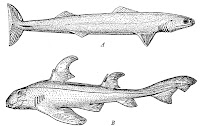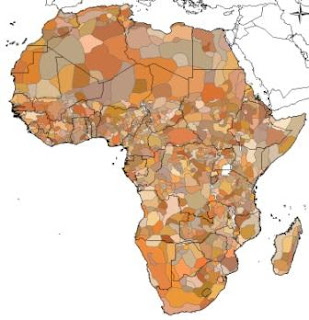Jerry Bergman reviews two centuries worth of claims for fish evolution. No empirical evidence exists for their evolution from non-fish, even though 80% of all known fossils are marine animals, mostly various types of fish. Fully formed fish appeared very “early” in the fossil record. One common theory—that fish evolved from some wormlike life-form—does not work at all, because the fossil gap between worms and fish is considerable and has never been bridged by the scientific evidence. Additional theories, such as fish having evolved from a more complex invertebrate, also fail. Dr. Bergman's conclusion: scientists cannot improve on Genesis 1:21: “God created the great creatures of the sea and every living and moving thing which the water teems according to their kinds.”
Selections from The Search for Evidence Concerning the Origin of Fish, by Jerry Bergman.
(These selections, edited by Marko Malyj, are of the article published in Creation Research Society Quarterly Journal, Volume 47, Number 4, Spring 2011)
(To receive new uMarko posts via a daily email, please click Subscribe)
(On Twitter: FOLLOW uMarko or http://www.twitter.com/uMarko)
Fish are one of the most common fossil types, with close to one half-million specimens in museums alone. But in spite of almost two centuries of searching, no evidence of gradual macroevolution has been found in this extremely abundant fossil record.
No Transitional Forms
The most common explanation is that few transitional fossils have been preserved. This is an incorrect conclusion, because we would also expect at least some of the modern fish we know today to be missing in the fossil record as well. However, every major fish kind known today has been found, indicating the completeness of the existing known fossil record (Benton, 2005). New fossil finds are almost always more of the same, and occasionally new species are discovered that only create more gaps in the fossil record and do not fill in existing gaps.
The evidence is exhaustive. Transitional forms have not been found, despite the expectations of evolutionists. Instead, all of them fit one of three categories:
 |
Devonian ostracoderms, now extinct,
demonstrate variety, not evolution. |
- Extinct fish, which may appear very different from familiar fish, and yet do not show evidence for evolution. Instead they demonstrate the enormous variation found in the natural world.
 |
"Devonian" sharks are virtually
indistiguishable from modern ones. |
- Fully modern fish that can easily be identified as such. (Many contemporary paleontologists admit that even the earliest known fossil fish has all of the basic characteristics of modern fish).
 |
Holopychius turned out not
to be the Missing Link for fish. |
- Fish once thought to be extinct such as the coelacanth and holoptychius (considered by many to be the “missing link” between fish and the tetrapods until the first Latimeria specimen was found off the east coast of South Africa in 1938).
Just One Connected Lineage of Fish Ancestors does not Fit the Evidence
In contrast to evolutionary assumptions, the fossil record of all basic classes of fish, including Agnatha, Placodermi, Acanthodii, Osteichthyes, and Chondrichthyes, began at close to the same evolutionary time, mostly during the Devonian or before (Botella, et al., 2007, p. 585).
There exists so much variety compared to all other life-forms that some evolutionists are forced to conclude that fish must not represent a single “lineage of creatures that evolved from a common ancestor” (Maisey, 1996, p. 10) but several separate lineages. But this requires even more fossils to support the separate lineages. Evidence of those kind of fossils once again does not exist.
Sometimes a single discovery can move the earliest known example of a vertebrate back by as much as 40 million years, forcing a major reevaluation of the fossil record (e.g., see Repetski, 1978, p. 529; Jablonski, et al., 2003). The problem for evolution is that new findings tend to push the origin of fish farther back in time. This makes it even harder to explain fish origins, because less time exists for them to evolve.
The Worm Theory does not Work Either
The putative oldest fish ancestor, and the ancestor of all chordates, is considered by many paleontologists to be a small wormlike fossil animal called Pikaia (Long, 1995, p. 30). But the changes required to evolve small round worms like nematodes to fish were enormous, because the “worm” that became a fish
did not look much like a fish. It probably had no paired fins, no real head, brain or advanced sense organs, jaws or teeth. Most likely, its body was cylindrical, with simple digestive organs, a nerve cord running its length from front to back, and below that a sort of stiffening, supporting rod which was its only skeleton, made of a soft material surrounded by a tough sheath. This forerunner of a backbone, or vertebral column, is called a notochord and from it the animals that possessed it, including all the vertebrates, derived their name—the chordates (Ommanney, 1971, p. 60).
Furthermore, to evolve a fish from a worm, the worm nervous and vascular systems would need to be flipped over, because the fish main organs are upside-down when compared to the worm organs. Furthermore, although some worms “have tiny eye-spots, earstones, and tactile or taste organs,” these structures are all relatively simple and microscopic in contrast to the fish’s welldeveloped eyes, rostrum, and a large head with an advanced vertebrate brain (Kyle, 1926, p. 3).
Most round and flat worms lack a heart, whereas fish have a very well-developed, powerful muscular pump that lies ventrally just behind the head. Each of the aforementioned unique fish features must have evolved, and one of the easiest to document should have been the evolution of fins because they show both “early” in the fossil record and with great clarity.
In fact, no evidence exists for any of these speculative transitions.
Many Generations of Evolutionists are Still Stuck on the Fish Problem
Eighty five years ago the fish biologist Kyle (1926, p. vii) concluded that fishes “occupy a peculiar position in the hierarchy of animal life” and that we “cannot be sure whence they came.”
Over fifty years ago, Gregory (1959, p. 123) was forced to say that “there are still many gaps” in the fossil record among fish.
Twenty four years ago, the creationist Gish "finds all the confessions he needs” in the writings of paleontologists to support the conclusion that each of the fish classes “appears suddenly and with no trace of ancestors” in the fossil record. (Strahler 1987, p. 408)
Today, the same is still true, and any possible evidence to the contrary has been exhausted. There is a complete lack of fossil evidence for fish evolution. Darwin’s claim has been falsified, thus supporting the creation account recorded in Genesis 1:21, which reads, “God created the great creatures of the sea and every living and moving thing which the water teems according to their kinds” (NIV).
References (selected)
Benton, M. 2005. Vertebrate Palaeontology. Blackwell, Malden, MA.
Botella, H., H. Blom, M. Dorda, P. E. Ahlberg, and P. Janvier. 2007. Jaws and teeth of the earliest bony fishes. Nature 448:583–586.
Gregory, W. K. 1959. Fish Skulls: A Study of the Evolution of Natural Mechanisms. Eric Lundberg, Laurel, FL.
Jablonski, D., K. Roy, J. W. Valentine, R. M. Price, and P. S. Anderson. 2003. The impact of the pull of the recent on the history of marine diversity. Science 300:1133–1135.
Kyle, H. M. 1926. The Biology of Fishes. The Macmillan Company, New York, NY.
Long, J. 1995. The Rise of Fishes: 500 Million Years of Evolution. Johns Hopkins University Press, Baltimore, MD.
Maisey, J. G. 1996. Discovering Fossil Fishes. Henry Holt, New York, NY.
Ommanney, F.D. 1971. The Fishes. Time Life Nature Library, New York, NY.
Repetski, J. E. 1978. A fish from the Upper Cambrian of North America. Science 200:529–531.
Strahler, A. N. 1987. Science and Earth History—The Evolution/Creation Controversy. Prometheus Books, Buffalo, NY.
 In a recent amusing story by the usually staid BBC, Michael Mosley claimed to find evidence of “fishy features” in human anatomy.1 Mosley, Clack, and others who reject the biblical account of creation must attempt to shoehorn scientific discoveries into uncomfortable—and often conflicting—evolutionary interpretations. They began by stating:
In a recent amusing story by the usually staid BBC, Michael Mosley claimed to find evidence of “fishy features” in human anatomy.1 Mosley, Clack, and others who reject the biblical account of creation must attempt to shoehorn scientific discoveries into uncomfortable—and often conflicting—evolutionary interpretations. They began by stating: 



























